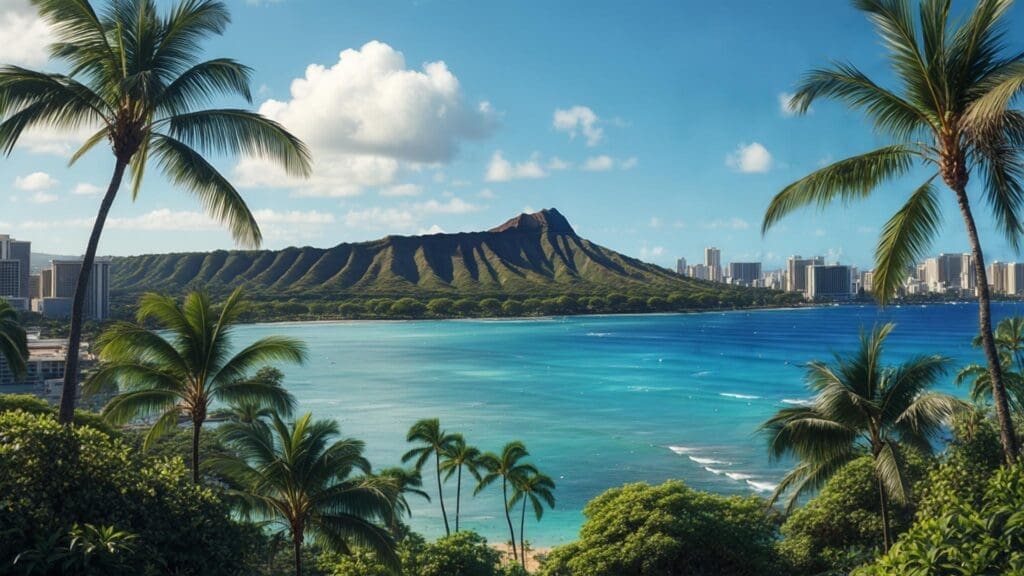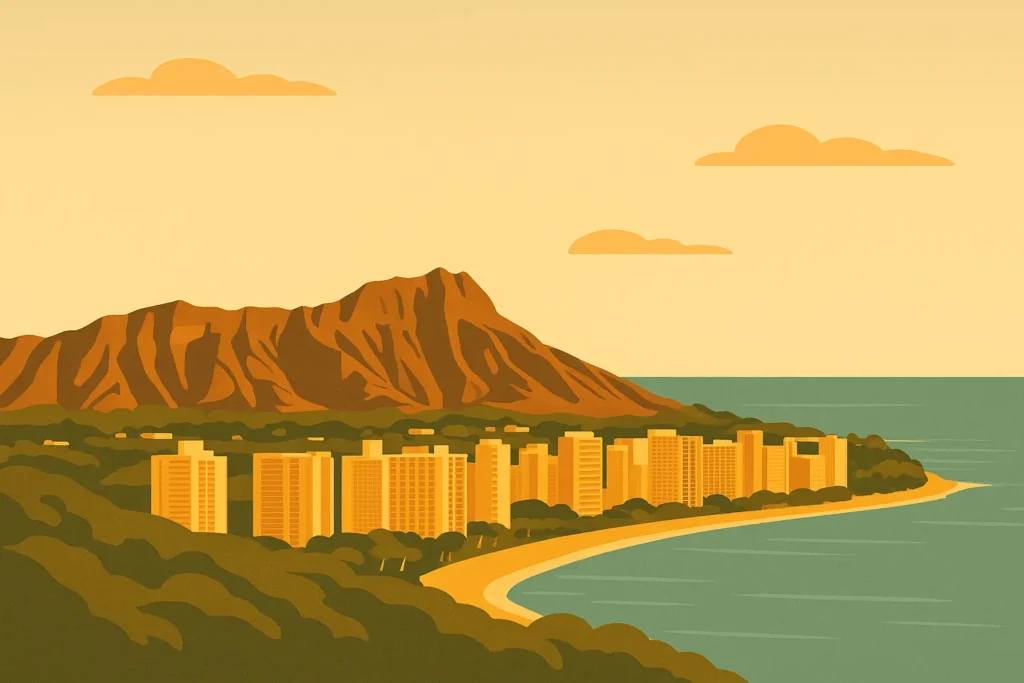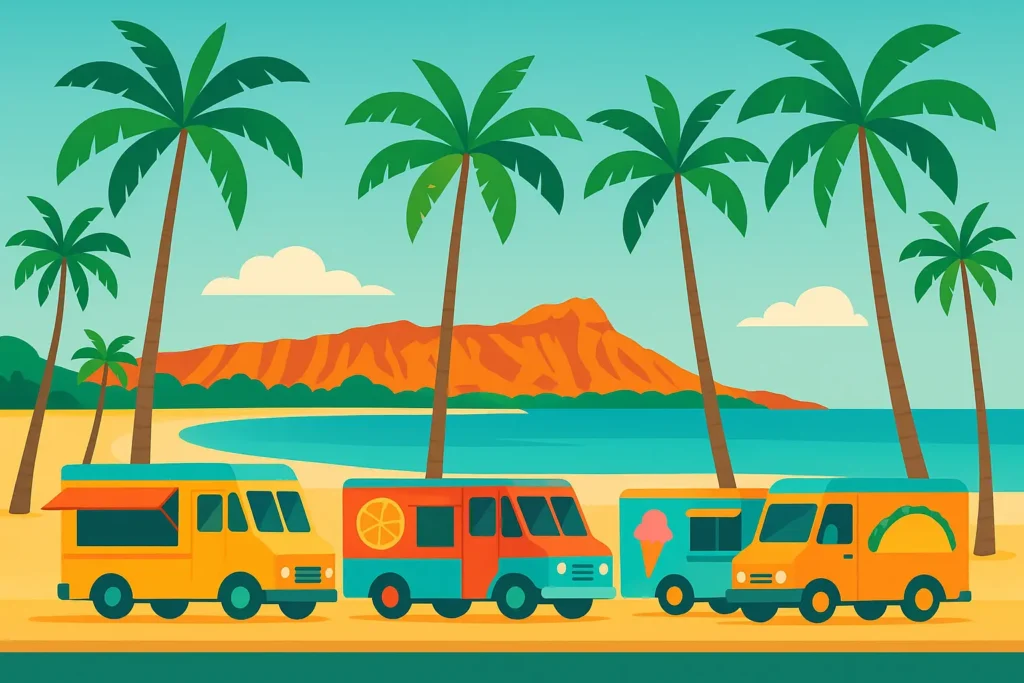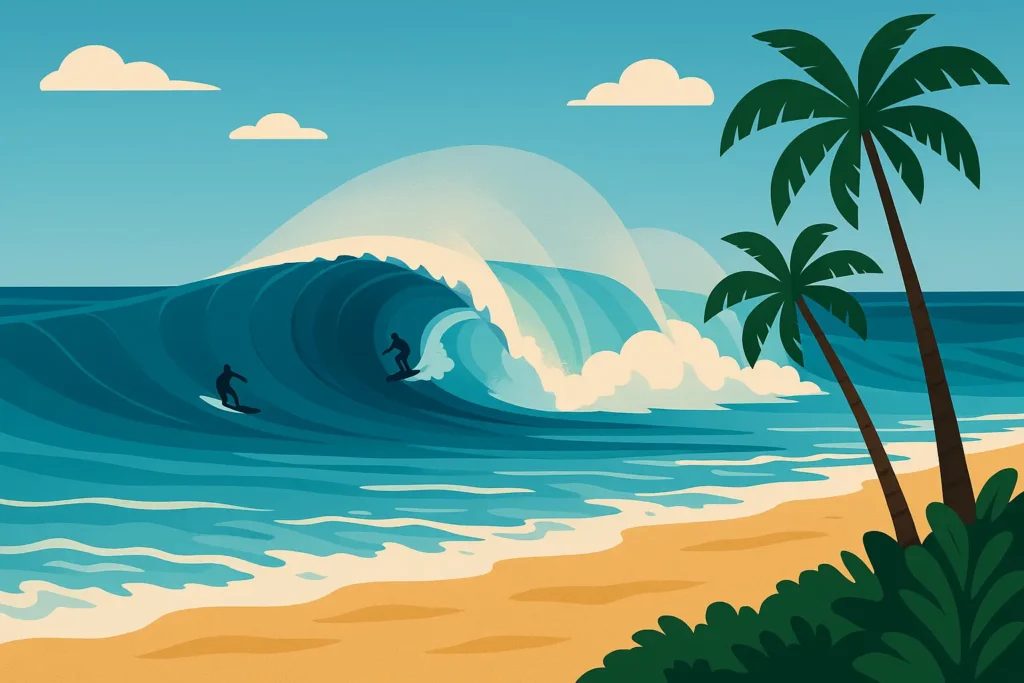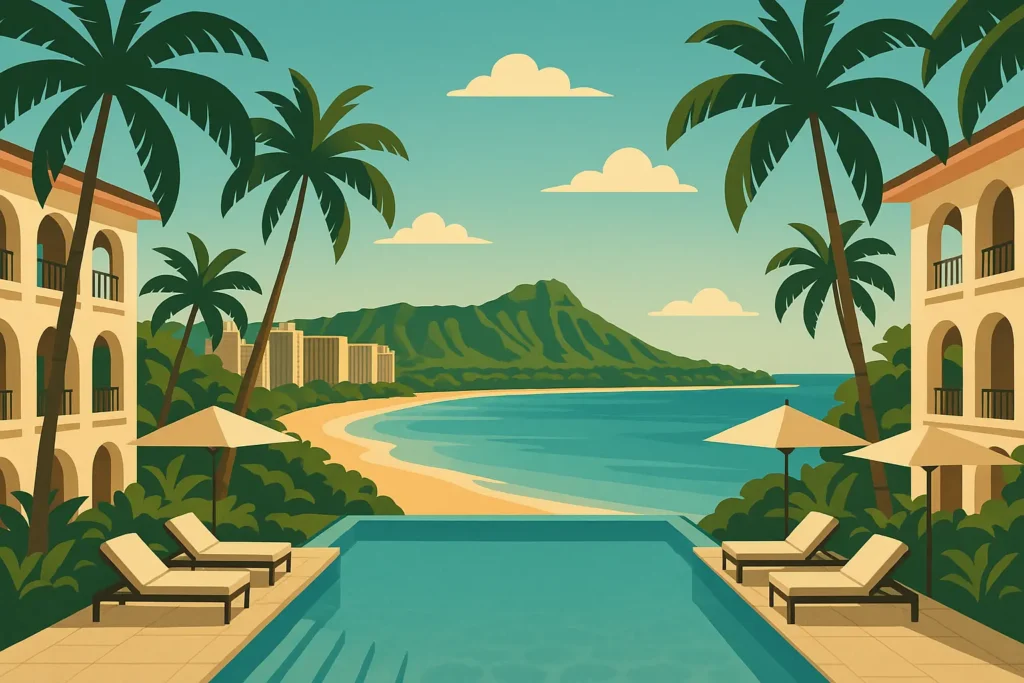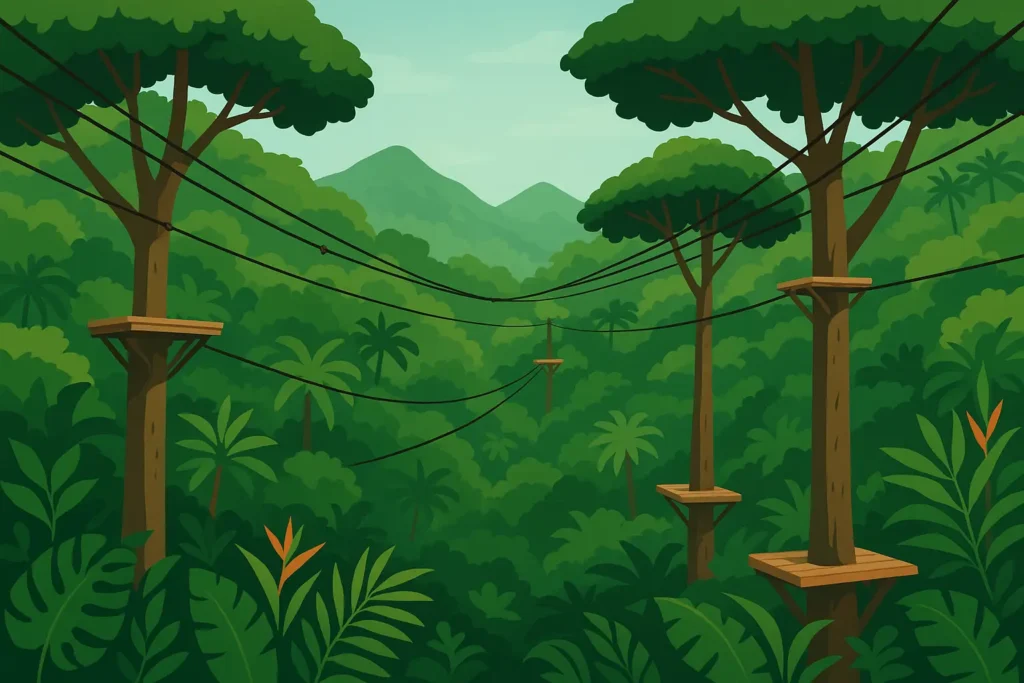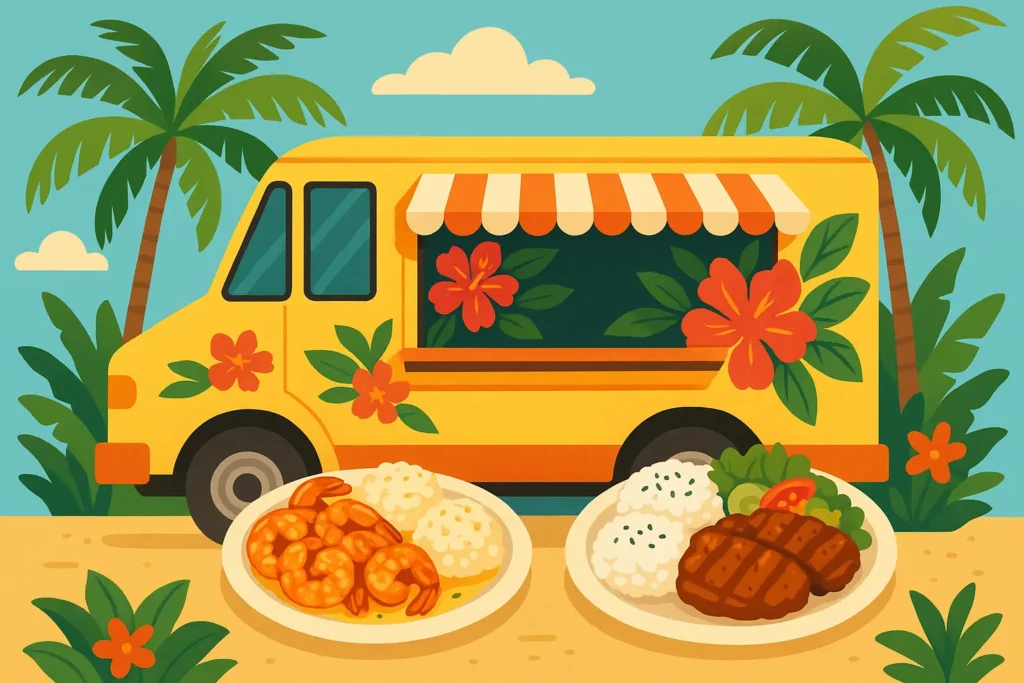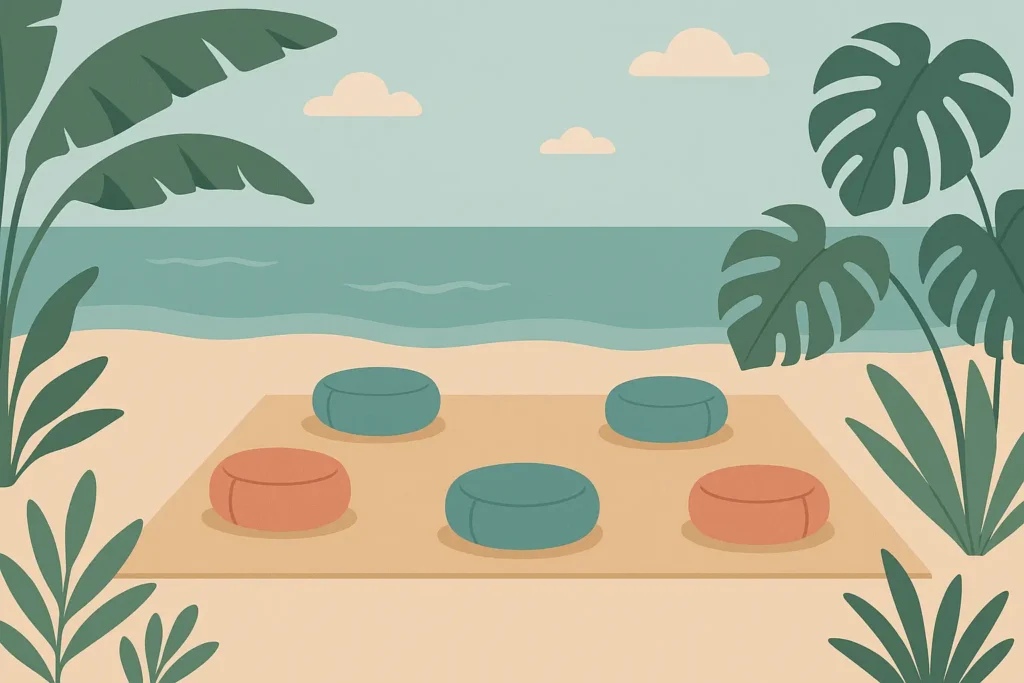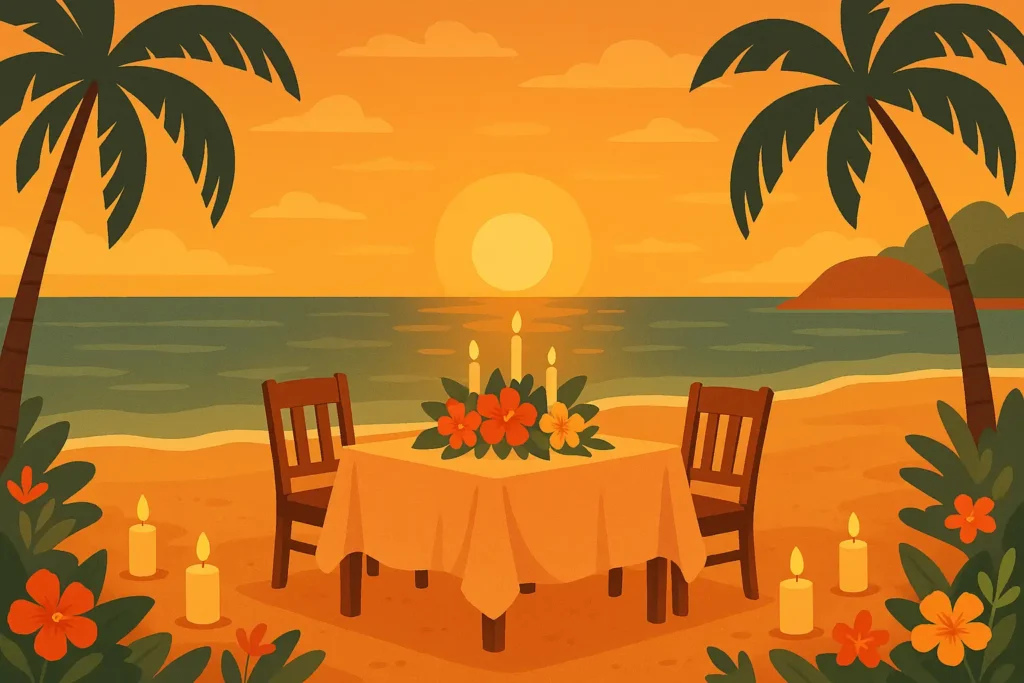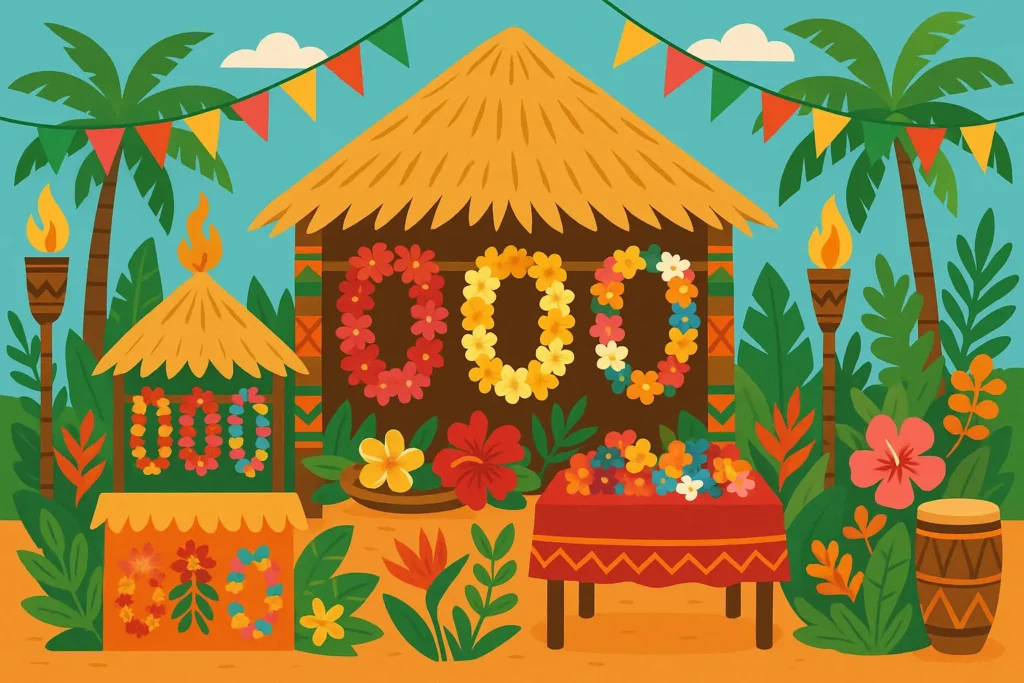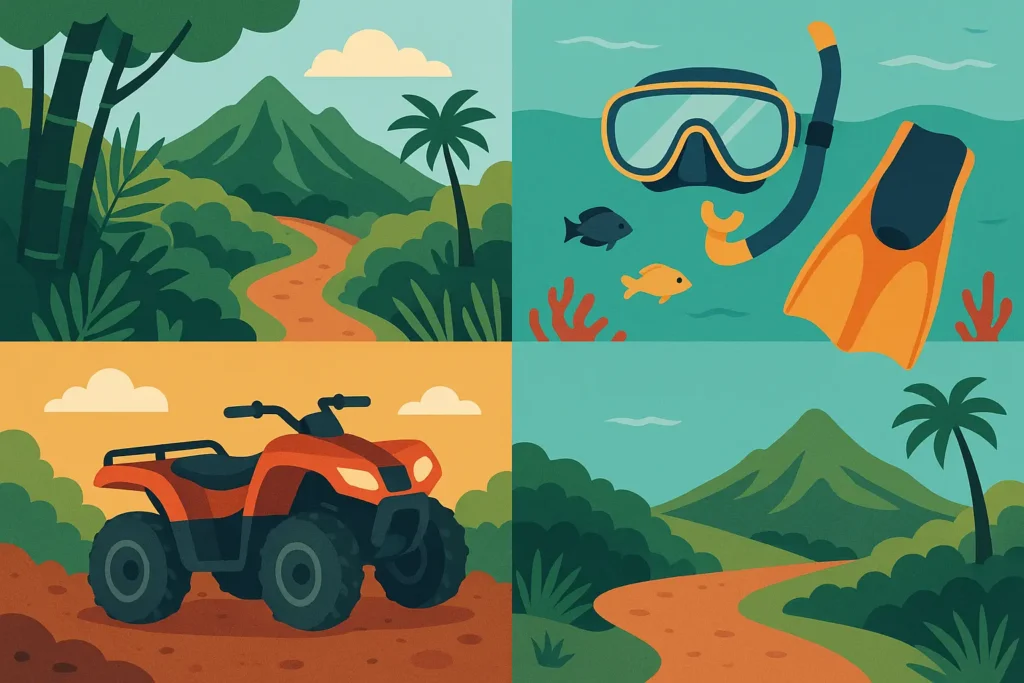Surfing lessons in Honolulu typically cost around $90 for 1-2 hours of personalized instruction, according to Love Oahu. I remember standing on Waikiki Beach three years ago, watching my friend Sarah attempt her first wave after booking one of these lessons. She’d spent months planning her Honolulu itinerary but felt completely overwhelmed by the endless activity options. That single surfing lesson became the highlight of her entire vacation, and it made me realize how crucial proper itinerary planning is for maximizing your Hawaiian experience.
Start building your dream Hawaii itinerary with our Vacation Planner
Look, planning a Honolulu vacation shouldn’t feel harder than your actual job. You deserve to experience the magic of Hawaii without the stress of figuring out logistics, timing, and budget constraints. Whether you’re dreaming of adventure-packed days or peaceful beach relaxation, the right itinerary transforms your trip from good to absolutely unforgettable.
Quick Resources
TL;DR
- Honolulu offers 25+ distinct itinerary styles ranging from 2-day weekend trips to 14+ day island-hopping adventures
- Budget planning spans from $50-75/day for backpackers (you’ll eat a lot of spam musubi) to $500-800/day for luxury honeymoon experiences (your biggest decision will be breakfast in bed or by the infinity pool)
- Activity-based itineraries include adventure seeking, beach relaxation, cultural immersion, foodie tours, and photography expeditions
- Group dynamics significantly impact planning – solo travelers, couples, families, and friend groups need completely different approaches (trust me on this one)
- Seasonal timing affects costs, crowds, and available activities, with winter surf season bringing waves that look like moving buildings
- Practical considerations like transportation, accommodation location, and weather preparation determine whether you’ll love or hate your trip
- Mid-range comfort itineraries ($150-250/day) provide the best balance of experiences, flexibility, and value for most travelers – this is the sweet spot
Essential Planning Considerations for Your Honolulu Adventure
Before diving into specific itineraries, you need to understand the fundamental factors that make or break a Honolulu vacation. Here’s the deal – how long you’re staying basically determines everything else about your trip. Your budget determines whether you’ll stay in hostels or luxury resorts, eat at food trucks or fine dining establishments.
Match your budget and travel style with our Vacation Planner
Travel style preferences – from adventure-seeking to cultural immersion – shape your entire experience. But here’s what nobody tells you: practical logistics including transportation, accommodation location, weather preparation, and safety considerations require advance planning to avoid vacation-ruining surprises.
Duration and Timing Strategy
Trip length fundamentally shapes your Honolulu itinerary experience. Weekend warriors (2-3 days) must prioritize ruthlessly, focusing on iconic highlights like Diamond Head and Waikiki Beach. I’ll be honest – trying to see everything in 48 hours is like speed dating with paradise. You’ll get a taste, but you won’t fall in love properly.
Week-long visitors can balance relaxation with exploration, while extended stays (10+ days) allow for deep cultural immersion and those spontaneous discoveries that everyone raves about on Instagram. Multi-week island hoppers use Honolulu as their base for exploring Hawaii’s diverse islands.
Peak season (December-April) delivers perfect weather but brings higher costs and overwhelming crowds. My buddy Jake thought he was being smart booking the cheapest hotel in Waikiki during peak season. Turns out, it was a 20-minute walk to the beach and right next to a construction site. Lesson learned: location matters more than saving $30 a night.
Time your trip right with help from our Vacation Planner
| Trip Duration | Best For | Key Advantages | Main Challenges |
|---|---|---|---|
| 2-3 Days | Weekend Warriors | Quick escape, highlights only | Limited depth, feels rushed as hell |
| 4-6 Days | First-time visitors | Good overview, manageable | Still somewhat rushed |
| 7-10 Days | Balanced exploration | Relaxation + adventure | Higher costs, more planning |
| 11-14 Days | Extended immersion | Local connections, flexibility | Significant investment |
| 15+ Days | Island hopping | Comprehensive experience | Major time/budget commitment |
Budget Reality Check
Let me get real with you about what your daily budget actually gets you. Budget backpackers ($50-75/day) rely on hostels, public transportation, and free activities. You’ll become best friends with the ABC Store (Hawaii’s version of 7-Eleven) and learn that a single banana costs $2. Yes, really. But you’ll have the best stories and gain authentic local interactions.
Mid-range travelers ($150-250/day) hit the sweet spot where you’re not eating ramen every meal but you’re also not dropping $40 on airport cocktails without wincing. You’ll enjoy hotel comfort, rental cars, and paid attractions while maintaining flexibility. This budget level offers the best value proposition for most people.
Luxury seekers ($400-600/day) access premium resorts, private tours, and exclusive experiences. Your biggest decision will be whether to have breakfast in bed or by the infinity pool. Family budgets require different calculations entirely – a family of four needs $200-350/day for comfortable experiences, and trust me, kids care more about the hotel pool than your $200 snorkeling tour.
Travel Style Alignment
Adventure seekers need high-energy itineraries packed with hiking, water sports, and adrenaline-pumping activities. Fair warning about the North Shore in winter – those waves look amazing in photos, but they’ll literally knock you over if you try to swim. Stick to watching the pros.
Beach bliss travelers prioritize relaxation, spa treatments, and leisurely ocean time. Cultural immersion enthusiasts focus on museums, local interactions, and traditional experiences. Don’t be that tourist who pronounces everything wrong and acts like Hawaii is just another beach destination. It’s a real place with real people who have a complex history.
Your group dynamics matter enormously. Solo travelers enjoy maximum flexibility but need safety considerations for water and hiking activities. Couples can focus on romantic experiences and intimate settings. Families require kid-friendly activities and backup plans for inevitable meltdowns. Friend groups want social activities, nightlife, and shared adventures – good luck balancing the person who wants to party until 3 AM with the one who wants sunrise yoga.
Practical Logistics Foundation
Transportation choices affect your entire itinerary. Walking and public buses ($2.75 per ride) limit your range but save money. TheBus is cheap but slow. Like, really slow. What Google Maps says is a 30-minute trip will take you an hour. Bring snacks.
Rental cars ($40-80/day plus gas) provide freedom but require parking considerations and traffic navigation. Rental cars in Hawaii cost more than your first apartment, and parking in Waikiki is like playing Tetris with your wallet. But having a car means you can escape the tourist bubble, which is priceless.
Here’s what the travel guides don’t mention: Waikiki smells like sunscreen and exhaust fumes by noon. It’s still beautiful, but your Instagram photos won’t capture that part. Other areas offer authenticity and value but require transportation planning.
Look, everyone’s Instagram shows perfect beach days, but it rains in Hawaii. Like, a lot. Hawaiian weather isn’t actually perfect 365 days a year, despite what your coworker who went once told you. It rains almost every afternoon for 15 minutes, then gets sunny again. Pack a rain jacket that doesn’t make you look like a walking tent.
Duration-Based Itineraries
Duration-based itineraries recognize that time constraints fundamentally shape your Hawaiian experience. Weekend warriors must maximize every moment with carefully curated highlights, while week-long visitors can balance must-see attractions with relaxation. Extended stays allow for deeper cultural connections and spontaneous discoveries that shorter trips can’t accommodate.
1. Weekend Warrior (2-3 Days)
Time pressure demands strategic planning for maximum impact. Day one combines Waikiki Beach acclimatization with the iconic Diamond Head hike. Pro tip: I totally underestimated how exhausting Diamond Head would be in 85-degree heat at 2 PM. Go early or you’ll be that tourist buying overpriced water from the vendor at the top.
Maximize short trips with our customizable Vacation Planner
Sarah’s Weekend Warrior Success Story: Sarah flew in Friday evening from Seattle, spent Saturday morning at Waikiki Beach learning to surf ($90 lesson – doesn’t include the $15 parking fee nobody mentions), hiked Diamond Head in the afternoon ($5 parking), and caught sunset at Tantalus Lookout (free). Sunday included Pearl Harbor morning tour ($35), Chinatown food walking tour ($65), and Ala Moana shopping before her red-eye flight. Total activity cost: $195 plus meals and accommodation. She said it felt rushed but incredible.
Day two shifts focus to historical significance with Pearl Harbor’s sobering memorials. Pearl Harbor booking tip that’ll save your sanity: They don’t allow ANY bags. Like, not even your tiny purse. There’s a bag storage place across the street that charges $7, but the line is usually 30 minutes long.
2. Classic Week (7 Days)
Seven days allows for proper pacing without feeling rushed. The first two days focus on Waikiki acclimatization and beach activities, giving your body time to adjust while experiencing Hawaii’s most famous coastline. Days three and four venture to the North Shore for Pipeline’s massive waves, Haleiwa’s charming town atmosphere, and legendary food trucks.
Giovanni’s shrimp truck on the North Shore: The line looks insane, the picnic tables are sticky, and you’ll get garlic butter under your fingernails. It’s also the best $15 you’ll spend in Hawaii. Cultural immersion fills days five and six with the Polynesian Cultural Center’s comprehensive Pacific Island experience and Iolani Palace’s royal Hawaiian history.
The final day provides relaxation and departure preparation, ensuring you leave refreshed rather than exhausted. This is crucial – nobody wants to need a vacation from their vacation.
3. Extended Explorer (10 Days)
Ten days unlocks Hawaii’s hidden gems and allows for weather contingencies. The first three days thoroughly explore Waikiki and Honolulu’s urban attractions. Days four through six focus on North Shore adventures and central Oahu’s pineapple plantations and cultural sites.
The windward coast and Kailua’s pristine beaches fill days seven and eight, offering a different perspective on island life. The final two days target local favorites and off-the-beaten-path discoveries that shorter itineraries can’t accommodate. This timeframe allows for spontaneous recommendations from locals and flexibility for weather-dependent activities.
4. Island Hopper (14+ Days)
Two weeks enables comprehensive multi-island exploration using Honolulu as your strategic base. The first four days provide thorough Oahu coverage, establishing your Hawaiian foundation. Days five through eight on the Big Island showcase volcanic landscapes and diverse climate zones impossible to experience elsewhere.
Maui’s days nine through twelve offer the perfect balance of beaches, mountains, and cultural sites. The final days back in Honolulu allow for reflection, final experiences, and relaxed departure preparation. This extended timeframe justifies the higher inter-island flight costs through comprehensive island experiences.
Budget-Conscious Travel Plans
Budget-based itineraries prove that financial constraints don’t limit Hawaiian magic – they simply require different approaches. Backpacker budgets emphasize free activities, local transportation, and authentic cultural interactions that luxury travelers often miss. Mid-range comfort provides the optimal balance of experiences and amenities for most visitors.
| Budget Level | Daily Range | Accommodation | Transportation | Dining | Activities |
|---|---|---|---|---|---|
| Backpacker | $50-75 | Hostels ($25-35) | Public bus ($2.75) | Food trucks ($10-15) | Free beaches, hiking |
| Mid-Range | $150-250 | Hotels ($100-150) | Rental car ($55) | Mix ($20-35) | Paid tours, attractions |
| Luxury | $400-600 | Resorts ($300-500) | Private transport | Fine dining ($85+) | Premium experiences |
| Family (4) | $200-350 | Suites/rentals | Rental car | Family restaurants | Kid-friendly activities |
| Honeymoon | $500-800 | Oceanfront suites | Premium rentals | Romantic dining | Couples experiences |
5. Budget Backpacker ($50-75/day)
Hostel life at HI Honolulu ($25-35/night) connects you with fellow travelers and provides insider tips from experienced staff. You’ll sleep in rooms with 6 strangers, but you’ll have the best stories. Free activities become your foundation – hiking Diamond Head costs only parking fees, while Waikiki Beach offers world-class experiences without admission charges.
TheBus system ($2.75 per ride) reaches every corner of Oahu with patience and planning. Food trucks and plate lunch counters ($10-15) provide authentic local flavors at fraction of restaurant costs. Sunscreen in Hawaii costs about $20 a bottle, so bring your own from home unless you enjoy financial pain with your sunburn.
6
6. Mid-Range Comfort ($150-250/day)
Mid-tier Waikiki hotels ($100-150/night) provide comfort without luxury price tags. This is the sweet spot where you’re not eating ramen every meal but you’re also not dropping ridiculous money on basic necessities. This budget allows mixing free beach time with paid experiences like snorkeling tours ($50-75) and cultural site admissions ($25-30).
Rental cars or strategic rideshare use provides transportation flexibility. Dining becomes more varied with casual restaurants ($20-35 per meal) supplemented by food truck discoveries. This budget level offers the best value proposition – enough comfort to enjoy your vacation without financial stress, plus flexibility to upgrade experiences that matter most to you.
Plan smart and travel well with our Vacation Planner
7. Luxury Experience ($400-600/day)
Five-star resorts ($300-500/night) provide oceanfront locations, premium amenities, and concierge services that eliminate planning stress. Your biggest decision will be whether to have breakfast in bed or by the infinity pool. Private tours and exclusive experiences offer personalized attention and access to restricted areas.
Premium transportation – private drivers or luxury car rentals – eliminates logistics concerns while providing comfort and status. This budget level maximizes convenience and minimizes effort, perfect for special occasions or travelers who prioritize comfort over cultural immersion.
8. Family Budget ($200-350/day for family of 4)
Family suites or vacation rentals provide space and kitchen facilities that hotels can’t match. Kid-friendly attractions like the Honolulu Zoo and Waikiki Aquarium offer educational entertainment at reasonable prices. Beach time remains free while providing hours of family entertainment.
Here’s the reality check: Your kids will be more interested in the hotel pool than the $200 snorkeling tour. Plan accordingly and save your money. Rental cars become essential for family logistics and flexibility. Mixing dining out with grocery preparation controls costs while accommodating picky eaters.
9. Honeymoon Splurge ($500-800/day)
Adults-only resorts or oceanfront suites create romantic atmospheres without family distractions. Couples spa treatments, sunset cruises, and private beach dinners justify higher costs through once-in-a-lifetime experiences. Premium car rentals or private transfers eliminate stress during your romantic getaway.
Fine dining and in-room service become standard rather than special occasions. This budget level focuses on creating perfect moments and lasting memories rather than maximizing activity quantity. Every detail receives attention to ensure your honeymoon exceeds expectations.
Activity-Focused Adventures
Activity-based itineraries cater to specific interests and energy levels, ensuring your vacation aligns with your passions. Adventure seekers need high-intensity outdoor activities and physical challenges that showcase Hawaii’s natural playground. Beach bliss travelers prioritize relaxation and ocean-based activities at a leisurely pace.
10. Adventure Seeker
High-energy outdoor activities define every day of your Hawaiian adventure. Diamond Head and Koko Head hikes provide challenging climbs with rewarding panoramic views. Imagine climbing stairs in a concrete tunnel that feels like a sauna, then emerging to views that make you forget you’re sweating through your shirt.
Shark cage diving sounds terrifying until you’re actually doing it. Then it’s just cold, salty, and you realize the sharks are way more interested in the fish than in you. Surfing lessons and stand-up paddleboarding develop new skills while connecting you with Hawaii’s ocean culture. Zipline tours through tropical canopies and ATV adventures across rugged terrain showcase the island’s diverse landscapes. Skydiving and parasailing provide aerial perspectives impossible to experience from ground level.
Physical fitness requirements vary significantly between activities. Weather dependency creates safety considerations that require flexible backup plans. Comprehensive travel insurance becomes essential for covering potential injuries during high-risk activities.
11. Beach Bliss
Ultimate relaxation focuses on Hawaii’s world-renowned beaches and ocean activities. Waikiki Beach provides convenient access to water sports rentals, beachside dining, and people-watching opportunities. Lanikai Beach offers pristine white sand and turquoise waters perfect for swimming and kayaking.
Sunset Beach and Pipeline showcase Hawaii’s famous surf culture during winter months. Winter surf season means you’ll see waves that look like moving buildings. It’s incredible to watch but don’t even think about swimming on the North Shore unless you have a death wish. Kailua Beach combines stunning scenery with calm waters ideal for stand-up paddleboarding and snorkeling.
Weather dependency affects beach activities significantly. Seasonal surf conditions determine which beaches offer calm swimming versus exciting wave watching. Sun protection and hydration become critical health considerations during extended beach time.
12. Cultural Immersion
Deep Hawaiian heritage experiences require patience and cultural sensitivity. Bishop Museum provides comprehensive Polynesian history and cultural artifacts. Iolani Palace offers insights into Hawaiian royalty and the complex history of American annexation.
Polynesian Cultural Center delivers full-day immersion in Pacific Island cultures through interactive demonstrations and performances. Traditional luaus and hula lessons connect you with living Hawaiian traditions. Getting a lomilomi massage where the therapist uses their forearms and works out knots you didn’t even know you had provides authentic cultural healing experiences.
Maria’s Cultural Deep Dive: Maria spent her 8-day trip focused entirely on Hawaiian culture. She visited Bishop Museum ($25), took private hula lessons ($85/session), attended an authentic family luau ($150), learned traditional lei making ($45), and spent two days at the Polynesian Cultural Center ($70). She stayed with a local family through a homestay program, practicing Hawaiian language basics and learning about contemporary island life challenges. She said it completely changed her perspective on what Hawaii really is.
Language barriers and unfamiliar customs require open-mindedness and respect. Some cultural sites have specific protocols and dress codes that visitors must follow. Advanced booking becomes essential for popular cultural attractions and authentic experiences.
13. Foodie Paradise
Culinary adventures showcase Hawaii’s unique fusion of Asian, Polynesian, and American influences. Food truck tours introduce you to local favorites like garlic shrimp, malasadas (Hawaiian donuts that are basically crack in pastry form – you’ve been warned), and plate lunches at authentic prices.
Chinatown markets offer exotic ingredients and traditional cooking techniques. North Shore shrimp trucks have achieved legendary status among food enthusiasts. Fine dining restaurants showcase Hawaii Regional Cuisine using local ingredients and innovative techniques. Coffee plantation tours and tropical fruit tastings highlight Hawaii’s agricultural diversity.
Dietary restrictions require advance research and communication with restaurants. Food safety considerations become important when trying street food and local specialties. Seasonal availability affects certain ingredients and dishes throughout the year.
14. Photography Expedition
Capturing Hawaii’s beauty requires strategic timing and location planning. Diamond Head sunrise provides iconic shots with perfect golden hour lighting. North Shore wave photography showcases the power and beauty of Hawaii’s famous surf breaks.
Botanical gardens offer controlled environments for macro photography and tropical plant studies. Waterfall chasing requires hiking skills and weather awareness for optimal conditions. Street photography in Chinatown and downtown captures local life and cultural diversity.
Equipment protection from sand, salt, and humidity becomes critical for camera gear. Weather dependency affects lighting conditions and accessibility to outdoor locations. Early morning and late afternoon timing maximizes photographic opportunities but requires schedule flexibility.
Special Interest Experiences
Special interest itineraries cater to travelers seeking specific outcomes beyond typical vacation activities. Wellness retreats focus on physical, mental, and spiritual renewal through traditional Hawaiian healing practices and modern spa treatments. History and education itineraries provide deep learning experiences about Hawaii’s complex past and cultural significance.
15. Wellness Retreat
Mind, body, and spirit renewal combines ancient Hawaiian healing traditions with modern wellness practices. Daily yoga sessions on the beach connect you with nature while improving physical flexibility and mental clarity. Meditation practices in peaceful settings help reduce stress and increase mindfulness.
Traditional Hawaiian healing experiences like lomilomi massage and ho’oponopono (reconciliation practices) offer cultural authenticity alongside therapeutic benefits. Spa treatments using local ingredients like kukui nut oil and volcanic clay provide unique Hawaiian wellness experiences.
Healthy dining focuses on fresh local ingredients, tropical fruits, and traditional Hawaiian foods prepared in nutritious ways. Nature walks and beach meditation sessions combine physical activity with spiritual practice.
16. History and Education
Learning-focused journeys require intellectual curiosity and patience for detailed information. Pearl Harbor’s comprehensive tour includes multiple memorials and museums that require full-day commitment. Hawaiian sovereignty and cultural history provide context for understanding modern Hawaii’s complex political landscape.
WWII sites throughout Oahu tell stories of Hawaii’s strategic military importance and civilian experiences during wartime. Plantation era exploration reveals the diverse immigrant communities that shaped modern Hawaiian culture. Modern Hawaiian political movements and sovereignty issues provide contemporary context.
Some historical sites have mobility restrictions and specific tour schedules. Advanced booking becomes essential for popular attractions like Pearl Harbor. Educational experiences require mental energy and may not appeal to travelers seeking pure relaxation.
17. Eco-Tourism Focus
Sustainable and conservation-minded travel requires commitment to environmental responsibility. Marine life conservation activities like coral reef restoration and sea turtle monitoring provide hands-on conservation experience. Certified sustainable tourism operators ensure your activities support rather than harm local ecosystems.
Volunteer opportunities with local environmental organizations offer meaningful ways to give back to Hawaii’s natural environment. Native plant restoration projects help preserve Hawaii’s unique endemic species. Ocean cleanup participation connects environmental action with beach enjoyment.
18. Spiritual Journey
Sacred sites and reflection opportunities connect you with Hawaii’s spiritual traditions and natural energy. Ancient Hawaiian temple visits (heiau) require respectful behavior and cultural sensitivity. These sites often have specific protocols and may restrict certain activities or photography.
Meditation at sacred locations like Diamond Head crater or secluded beaches provides powerful spiritual experiences. Traditional blessing ceremonies performed by Hawaiian cultural practitioners offer authentic spiritual connections. Mindfulness practices and connection with nature form the foundation of Hawaiian spiritual traditions.
Group Dynamic Itineraries
Group dynamics fundamentally change itinerary planning requirements and activity choices. Solo travelers enjoy maximum flexibility but need safety considerations and social opportunities. Romantic couples prioritize intimate experiences and privacy. Families require kid-friendly activities, flexible schedules, and backup plans for various age groups.
19. Solo Traveler Adventure
Independent exploration provides maximum flexibility for spontaneous discoveries and personal interests. Flexible daily schedules allow you to extend activities you enjoy or skip experiences that don’t appeal to you. Group tour options provide safety for water activities and hiking while offering opportunities to meet fellow travelers.
Hostel accommodations or boutique hotels facilitate social interactions with other solo travelers. Photography and journaling opportunities help document your personal journey and reflections. Local interaction and cultural exchange become easier when traveling alone, as locals often approach solo travelers more readily.
Safety considerations become paramount for water activities, hiking, and nighttime exploration. Solo dining may feel uncomfortable initially but often leads to conversations with locals and staff.
20. Romantic Couples Getaway
Intimate and romantic experiences focus on creating lasting memories together. Private beach dinners and sunset cruises provide romantic settings away from crowds. Couples spa treatments and massages offer relaxation and bonding opportunities.
Romantic hiking to secluded spots combines adventure with privacy. Wine tasting and fine dining experiences create sophisticated entertainment options. Adults-only resort amenities ensure peaceful, romantic atmospheres without family distractions.
Compromise becomes essential when partners have different activity preferences. Higher costs for private experiences and romantic restaurants require budget planning.
21. Family Fun Focus
Multi-generational entertainment requires activities suitable for various ages and physical abilities. Kid-friendly beaches with calm waters and lifeguard supervision provide safe family fun. Educational attractions like aquariums and cultural sites offer learning opportunities disguised as entertainment.
The Johnson Family’s Perfect Week: With kids aged 6, 10, and 14, the Johnsons balanced everyone’s interests. They spent mornings at calm beaches (Kailua for the little ones, Waikiki for boogie boarding), afternoons at kid-friendly attractions (Honolulu Zoo $19/adult, Sea Life Park $45/adult), and evenings at family luaus ($89/adult, $45/child). Their vacation rental with kitchen saved money on breakfast and snacks while accommodating different wake-up times.
Family-style dining and local favorites accommodate picky eaters while introducing new flavors gradually. Easy hiking trails suitable for all ages provide outdoor adventure without overwhelming younger or older family members.
22. Friend Group Party
Social and energetic activities focus on shared experiences and group bonding. Friend groups in Hawaii: Someone will always want to party until 3 AM while someone else wants to wake up for sunrise yoga. Good luck with that. Group accommodations like vacation rentals provide space for socializing and cost savings through shared expenses.
Nightlife and entertainment districts offer options for various group preferences and energy levels. Group water sports and beach games create competitive fun and photo opportunities. Food tours and group dining experiences accommodate different tastes while ensuring everyone eats together.
Seasonal and Event-Based Plans
Seasonal timing dramatically affects your Hawaiian experience through weather patterns, crowd levels, and available activities. Winter surf season brings world-class wave watching but potentially rough ocean conditions for swimming. Summer festivals showcase Hawaiian culture and traditions but increase tourist crowds and costs.
23. Winter Surf Season (November-February)
Big wave and surf culture focus takes advantage of Hawaii’s most famous natural phenomenon. North Shore surf competitions like the Pipeline Masters provide world-class entertainment and cultural immersion. Professional surfers and locals gather to witness nature’s power and athletic skill.
Winter surf season means you’ll see waves that look like moving buildings. It’s incredible to watch but don’t even think about swimming on the North Shore unless you have a death wish. Surfing lessons during optimal wave conditions offer authentic Hawaiian experiences, though beginners should stick to protected areas like Waikiki.
Season Weather Crowd Level Average Daily Cost Best Activities Challenges Winter (Nov-Feb) 70-80°F, occasional rain High $200-300 Surf watching, hiking Rough ocean, higher prices Spring (Mar-May) 75-85°F, mild trade winds Medium $150-250 All activities Some lingering crowds Summer (Jun-Aug) 80-90°F, consistent sun High $250-350 Beach activities, festivals Heat, peak tourism Fall (Sep Fall (Sep-Nov) 75-85°F, variable Low-Medium $125-200 Best value period Hurricane season
Winter weather requires backup indoor activities for rainy days and rough ocean conditions. Higher accommodation costs during peak season affect budget planning.
24. Summer Festival Season (May-September)
Cultural events and celebrations showcase authentic Hawaiian traditions and contemporary island culture. Traditional Hawaiian festivals like the King Kamehameha Day celebration provide historical context and cultural education. Music festivals and cultural events offer entertainment and local interaction opportunities.
Summer in Hawaii is hot. Like, really hot. And humid. Your hair will do things you didn’t know were possible. Summer-specific outdoor activities take advantage of calmer ocean conditions and extended daylight hours. Extended daylight provides more time for activities and reduces pressure on daily scheduling.
Higher costs during summer tourist season affect accommodation and activity prices. Increased crowds at popular attractions require patience and advance planning.
25. Holiday and New Year Celebration
Festive season special planning creates unique memories during Hawaii’s most celebratory time. New Year’s Eve fireworks at Waikiki provide spectacular entertainment in a tropical setting. Holiday-themed cultural celebrations blend Hawaiian traditions with familiar holiday customs.
Special holiday dining experiences offer unique menus and festive atmospheres. Year-end reflection and goal-setting activities provide meaningful ways to transition between years in paradise. Peak season pricing reaches its highest levels during holidays, significantly affecting budgets.
Real-World Itinerary Examples
Detailed examples demonstrate how theoretical planning translates into practical daily schedules with real costs and logistics. The mid-range comfort example shows how $150-250 daily budgets provide balanced experiences mixing free activities with paid attractions.
Mid-Range Comfort 7-Day Breakdown
Day-by-day cost analysis reveals how mid-range budgets ($150-250/day) provide optimal value and flexibility. Waikiki Beach Marriott ($140/night) offers comfort and location without luxury price tags. Free activities like beach time balance paid experiences like Diamond Head hiking ($5 parking) and cultural site tours ($25-30 admission).
Transportation costs vary significantly based on choices – rental cars ($55/day) provide freedom but require parking fees and gas. Food expenses range from food truck meals ($12-15) to fine dining experiences ($85), allowing budget flexibility based on daily preferences.
Weekly totals average $205/day including accommodation, meals, transportation, and activities. This budget level provides comfort without financial stress while allowing spontaneous upgrades for special experiences.
Adventure Seeker 5-Day Intensive
High-intensity outdoor activities require careful scheduling and physical preparation. Early morning starts maximize optimal weather conditions and avoid afternoon heat. Multiple activities per day demand excellent physical fitness and energy management.
I once spent $300 on a helicopter tour that got cancelled due to weather. Twice. Book through your hotel concierge – they usually have better cancellation policies. Extreme sports like skydiving ($250) and shark cage diving ($150) represent significant budget investments but provide once-in-a-lifetime experiences.
Recovery time between intense activities becomes essential for safety and enjoyment. Weather dependency creates potential schedule disruptions requiring flexible backup plans.
How Bridesmaid for Hire Can Elevate Your Hawaiian Experience
Planning the perfect Honolulu itinerary creates similar challenges to wedding planning – overwhelming options, complex logistics, and high stakes for creating unforgettable memories. Bridesmaid for Hire’s expertise in managing detailed event planning translates perfectly to Hawaiian vacation coordination.
Our professional problem-solving experience from 150+ weddings provides the skills needed to handle travel group dynamics, family vacation conflicts, and unexpected itinerary changes. We understand how to balance different preferences within groups while ensuring everyone enjoys their Hawaiian adventure.
For destination weddings in Honolulu or Hawaiian honeymoons, Bridesmaid for Hire offers comprehensive support throughout your entire journey. From initial planning through airport departure, we handle logistics, reservations, and contingency planning so you can focus on enjoying your special celebration.
Planning a Hawaii trip shouldn’t feel harder than your actual job. If you want someone who’s been through all the rookie mistakes to help you avoid them, hit us up. We’ve learned the hard way so you don’t have to.
Final Thoughts
Your perfect Honolulu itinerary exists within these 25 comprehensive options, each designed to match specific travel styles, budgets, and group dynamics. The key lies in honest self-assessment of your priorities, physical capabilities, and financial comfort zone.
Stop overthinking it. Hawaii is pretty hard to mess up. Even if it rains, even if you miss that tour, even if you spend too much on a mediocre mai tai – you’re still in freaking Hawaii. Remember that flexibility often creates the most memorable experiences. Weather changes, local recommendations, and spontaneous discoveries frequently become vacation highlights that rigid planning can’t anticipate.
I’m not gonna sugarcoat it – if you’re the type who needs everything planned to the minute, Hawaii might stress you out. Island time is real, and fighting it is like arguing with the ocean. Build buffer time into your schedule and maintain openness to unexpected opportunities.
Hawaii’s magic isn’t limited to expensive resorts or extreme adventures. Some of the most profound experiences – sunrise hikes, local food discoveries, cultural conversations – cost little but provide lasting memories. Your budget doesn’t determine your experience quality; your attitude and preparation do.
Start planning your Hawaiian adventure today, knowing that proper preparation creates the foundation for spontaneous magic. Whether you choose budget backpacking or luxury indulgence, adventure seeking or beach bliss, your perfect Honolulu experience awaits.
Begin your Honolulu planning journey with our Vacation Planner
1-800-BRIDESMAID
The Newlywed
Card Game
something extra to love
Read the weekly newsletter from Bridesmaid for Hire, 1-800-Bridesmaid, to hear about real stories, from strangers, who need advice on love, life, friendship, and so much more.
Looking for the perfect wedding gift for someone you adore? Grab The Newlywed Card Game. It's a fun and interactive game they can play on their honeymoon or future date nights.
